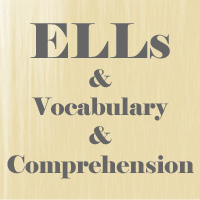
by Ana Taboada Barber
George Mason University
February 12, 2014
Vaughn, S., Martinez, L. R., Linan-Thompson, S., Reutebuch, C. K., Carlson, C. D., & Francis, D. J. (2009). Enhancing social studies vocabulary and comprehension for seventh-grade English Language Learners: Findings from two experimental studies. Journal of Research on Educational Effectiveness, 2(4), 297–324. doi:10.1080/19345740903167018
 Most teachers in the U.S. are well acquainted with English Language Learners' (ELLs) struggles with academics, especially with reading comprehension. For instance, on the 2011 National Assessment of Educational Progress (NAEP), 69 percent of fourth-graders and 71 percent of eighth-graders identified as ELLs scored below the basic level in reading. In contrast, among English monolingual (EM) students, an average of 25 percent were below the basic level in reading in both grades (U.S. Department of Education, 2011). Although this does not come as a surprise to most teachers, it is not less worrisome; more so in view of the emphasis on literacy across the curriculum required in Common Core State Standards (CCSS, 2010). Although quite a bit is known about word-level skills and early literacy processes in ELLs (e.g., Lesaux & Geva, 2006), there is much less research on how to help these students with their comprehension, especially as they reach the adolescent years and have to contend with complex content-area texts. An exception is intervention work developed by Vaughn and colleagues (Vaughn, Martinez, Linan-Thompson, Reutebuch et al., 2009) in which 7th grade ELLs received comprehension instruction in social studies with instructional practices targeted to meet both their vocabulary and reading comprehension needs. Some useful lessons learned from this study, supported by other research designed to improve comprehension in ELLs, are:
Most teachers in the U.S. are well acquainted with English Language Learners' (ELLs) struggles with academics, especially with reading comprehension. For instance, on the 2011 National Assessment of Educational Progress (NAEP), 69 percent of fourth-graders and 71 percent of eighth-graders identified as ELLs scored below the basic level in reading. In contrast, among English monolingual (EM) students, an average of 25 percent were below the basic level in reading in both grades (U.S. Department of Education, 2011). Although this does not come as a surprise to most teachers, it is not less worrisome; more so in view of the emphasis on literacy across the curriculum required in Common Core State Standards (CCSS, 2010). Although quite a bit is known about word-level skills and early literacy processes in ELLs (e.g., Lesaux & Geva, 2006), there is much less research on how to help these students with their comprehension, especially as they reach the adolescent years and have to contend with complex content-area texts. An exception is intervention work developed by Vaughn and colleagues (Vaughn, Martinez, Linan-Thompson, Reutebuch et al., 2009) in which 7th grade ELLs received comprehension instruction in social studies with instructional practices targeted to meet both their vocabulary and reading comprehension needs. Some useful lessons learned from this study, supported by other research designed to improve comprehension in ELLs, are:
- Teach vocabulary. Research has shown that students' ability to learn textbook vocabulary is improved when explicit vocabulary instruction is integrated with content-area reading. Teaching vocabulary explicitly includes making use of ELL's first language, through the use of:
- cognates (words of similar spelling and meaning)
- providing visual representations of the word
- giving student friendly definitions
- providing repeated exposure to words that are directly taught and embedded in meaningful contexts (Vaughn et al., 2009)
- making use of word roots or morphological awareness (awareness of word parts or morphemes and word formation rules; e.g., Kieffer & Lesaux, 2012).
In one of our own studies (Taboada & Rutherford, 2011) we found that ELLs could benefit from explicit, direct vocabulary instruction of specific science words (e.g., adaptation, camouflage, predator) as well as from embedded vocabulary instruction that was part of instruction of cognitive strategies (e.g., learning specific text words while learning to ask text-based questions). So, maximizing time spent with text that has well built glossaries and text features—such as bold words for key concepts—is important for these students.
- Use video strategically to teach and build discussion of key concepts. Incorporating short video clips into lessons is one way to anchor instruction on key content concepts for students, as well as to provide background knowledge on topics that are unfamiliar to ELLs. In their study, Vaughn and colleagues used short video clips to teach social studies concepts, either before or after students read a passage. Teachers had students focus on one or two key questions prior to video use.
- Use graphic organizers built by students. The use of graphic organizers, such as semantic maps, advanced organizers, Venn diagrams, concept diagrams, and so on was also part of the Vaughn et al. study. Using graphic organizers in relation to texts helps students organize text information and have a solid base for improving reading comprehension in typical on-grade readers (National Institute of Child Health and Human Development [NICHD], 2000). The use of student-constructed organizers also helps ELLs better understand the big ideas, or key concepts, from text and make connections among and between concepts (Deshler & Schumaker, 2006). Further, boiling down key ideas to less text helps ELLs with prioritizing information and learning essential vocabulary. In our own research with Grade 6 and 7 ELLs and English Monolinguals (EMs), we found that graphic organizers teaching students how to identify main ideas from paragraphs were especially helpful and predicted reading comprehension in ELLs (Taboada, Barber, Buehl, Kidd, Sturtevant et al., in press).
- Use structured paired reading to support comprehension and oral language development. Vaughn and colleagues paired ELLs with EMs according to language ability and standardized reading scores. This pairing helped students with similar language background challenge and support each other in the discussion of key ideas while giving corrective feedback. Pairs successfully discussed specific words that had been previously explicitly taught by the teacher and that were related to the big ideas in a particular lesson. In our own work with Grades 6 and 7 ELLs, we provided written guidelines (after modeling these) regarding how to handle roles in partner reading, with student pairs taking turns reading assigned text sections, one partner asking questions after reading and both rereading silently before attempting to answer their partners' questions. Questions had to follow adequate use of question words, and when possible, correct use of English for forming questions (e.g., verb position). Poster guidelines provided support for these language dimensions so ELLs could focus more on the content of their questions while having extra support for question forms (Taboada Barber & Buehl, 2013).
- Teach other comprehension strategies explicitly. ELLs of intermediate to advanced levels of English proficiency should be exposed to comprehension strategies as part of their regular reading instruction (e.g., Taboada, 2009). Grade 6 and 7 ELLs in the Taboada et al. study benefited from strategy instruction, including activation of background knowledge, identification of main idea, and comprehension monitoring as much as EMs when these were taught following the guided release of responsibility model (i.e., explicit explanation, modeling, guide practice, independent practice) and a variety of texts to use these. In other words, although it is well known that ELLs struggle with vocabulary and this is a key factor affecting their comprehension, general comprehension strategies that help with paragraph and inferential comprehension should not be marginalized.
- Support ELLs' reading engagement. Although not a focus of the Vaughn et al study, it is important to note that similar principles that apply to supporting the reading engagement of EMs apply to ELLs. In particular, teachers should engage in the following:
- matching text to students (Guthrie, 2008) so ELLs can access texts independently while also reading texts that are slightly above their level and require appropriate teacher scaffolds
- supporting their reading self-efficacy such that ELLs learn exactly what they are doing well in reading, and what dimensions of their reading need help and improvement (Taboada Barber & Buehl, 2013)
- offering choices of texts when possible, especially within a topic so they can deepen their knowledge about specific topics (Taboada & Rutherford, 2011)
- providing relevant explanations, so students know why certain reading activities are important and why specific content bears relevance to their lives (Taboada Barber et al., in press).
Deshler, D. D., & Schumaker, J. B. (2006). Teaching adolescents with disabilities: Accessing the general education curriculum. Thousand Oaks, Calif.: Corwin Press.
Guthrie, J. T. (2008). Engaging adolescents in reading. Thousand Oaks, CA: Corwin Press.
Kieffer, M. J., & Lesaux, N. K. (2012). Development of morphological awareness and vocabulary knowledge in Spanish-speaking language minority learners: A parallel process latent growth curve model. Applied Psycholinguistics, 33(01), 23–54. doi:10.1017/S0142716411000099.
Lesaux, N. K. & Geva, E. (2006). Synthesis: Development of literacy in language minority students. In D. L. August & T. Shanahan (Eds.), Developing literacy in a second language: Report of the National Literacy Panel (pp.53-74). Mahwah, NJ: Lawrence Erlbaum Associates.
National Institute of Child Health and Human Development (NICHD). (2000). Report of the National Reading Panel: Teaching children to read: An evidence-based assessment of the scientific research literature on reading and its implications for reading instruction. (No. NIH Publication No. 00-4769). Washington, DC: U.S. Government Printing Office. Retrieved from https://www.nichd.nih.gov/publications/pubs/nrp/pages/smallbook.aspx
Taboada, A., & Rutherford, V. (2011). Developing reading comprehension and academic vocabulary for English Language Learners through science content: A formative experiment. Reading Psychology, 32(2), 113–157. doi:10.1080/02702711003604468
Taboada Barber, A., & Buehl, M. M. (2013). Relations among grade 4 students’ perceptions of autonomy, engagement in science, and reading motivation. The Journal of Experimental Education, 81(1), 22–43. doi:10.1080/00220973.2011.630045
Taboada Barber, A., Buehl, M. M, Kidd, J. K., Sturtevant, E., Richey, L. N., Beck, J. (in press). Engagement in social studies: Exploring the role of a social studies literacy intervention on reading comprehension, reading self-efficacy, and engagement in middle school students with different language backgrounds. Reading Psychology.
Vaughn, S., Martinez, L. R., Linan-Thompson, S., Reutebuch, C. K., Carlson, C. D., & Francis, D. J. (2009). Enhancing social studies vocabulary and comprehension for seventh-grade English Language Learners: Findings from two experimental studies. Journal of Research on Educational Effectiveness, 2(4), 297–324. doi:10.1080/19345740903167018
This article is from the International Reading Association’s Literacy Research Panel. Reader response is welcomed. E-mail your comments to LRP@/